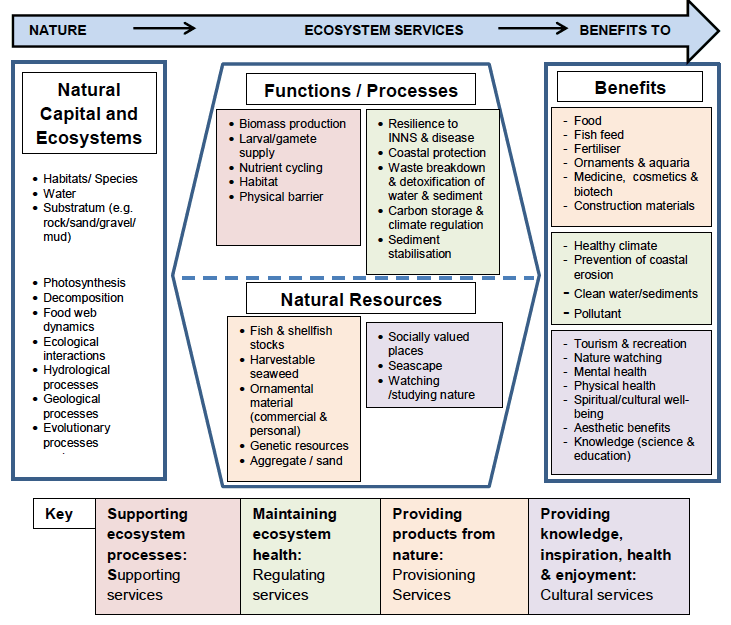Improving protection given to Priority Marine Features outside the Marine Protected Area network
A consultation seeking views on the scope of the project to improve protection given to PMFs outside the MPA network.
Annex C – Ecosystem Services
The 11 habitats and species provide benefits to society which are summarised in the SNH advice documents. The classification system used has been adapted from Potts et al. (2014). Figure 8 shows how the basic components of nature give rise to functions, processes and natural resources which, either directly or indirectly, provide benefits for people. Behind this simple premise are many complex interactions and cyclical feedback mechanisms, whereby a function or process can contribute to many different benefits. Similarly, a benefit can be dependent on many different processes and ecosystem components.

Figure 8. Nature has functions & processes and creates natural resources, all of which provide benefits for people.
Linking a function / process or natural resource with a feature does not necessarily mean that the end benefit is realised. Ensuring that benefits are realised often requires people to do something. For example, delivering food will require some kind of fishing or harvesting activity, or ensuring enjoyment of marine nature may require work to provide access to and along the coastline. In some cases, we may be able to identify opportunities to increase the flow of benefits from nature through intervention. However, there may be situations where human pressure prevents an ecosystem from sustaining itself. In such cases reduction in benefits to people is likely to occur.
Glossary of ecosystem service terms
Biomass production - the formation of biological material through photosynthesis or consumption of organic matter.
Larval/gamete supply - quantity, quality & dispersal potential of larva/gametes. This supply may positively affect the production area, but can also affect a much wider area depending on the environmental variables affecting that location.
Nutrient cycling - movement or exchange of nutrients such as nitrates and phosphates back in to the production of matter.
Habitat for other species - geological or biological material providing a habitat for other species.
Physical barriers - natural barriers to the movement of water or solid matter.
Resilience to INNS & disease – Healthy habitats/populations are likely to make a greater contribution to the ability of an ecosystem to resist, recover from or adapt to the introduction of a non-native or disease/pathogen.
Natural coastal protection - habitats and geomorphology which attenuate or block wave energy from reaching parts of the coast and foreshore with sensitive natural or built assets.
Waste breakdown & detoxification - physical or chemical change to contamination levels by species/habitats removing contaminants through consumption or filtering, or otherwise help lock contaminants in to substrate.
Carbon storage & climate regulation - storage or sequestration of organic or inorganic carbon within biomass or sediment or geological material.
Stabilisation of sediment - transfer of sediment from water column to seabed caused by the physical structure of habitats changing water movement that would otherwise keep sediment suspended.
Fish & shellfish stocks - harvestable wild fish and shellfish for commercial market or personal use / recreational fishing.
Harvestable seaweed - seaweed collectable for commercial or personal use.
Ornamental material - shells or other natural material collected for display or as trinkets/memorabilia, whether for commercial sale or personal use.
Genetic resources - species with potential use in, for example, biomedicine, food/nutrition or cosmetics, whether as raw material or isolation of genetic properties.
Aggregate / sand - sediment and rock resources identified for potential extraction and use in construction.
Socially valued places - Locations which someone places non-monetary value upon, regardless of whether or not they actively use or enjoy the natural assets at that location.
Seascape - the aesthetic qualities and character (visual and sense of place) of areas of sea or coast with which human society has a connection.
Watching/studying nature - species and habitats which people enjoy, study or observe.
Contact
- Marine Conservation team
0131 244 1617
There is a problem
Thanks for your feedback